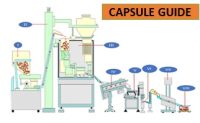End Point Detection in Wet Granulation: A Guide

This article describes the End point detection in Tablet manufacturing process for wet granulation i.e. why its is important, How it can be detected, How to fix it for new batches and what are techniques used for detection in various equipment.
End Point Detection in Wet Granulation: A Guide
What is End Point Detection?
End point detection is the process of identifying when the granulation process is complete. It involves the identification of the point at which the powder mixture has been converted into granules of the desired size, shape, and density. The end point is typically identified using various techniques that are designed to detect changes in the physical and chemical properties of the granules.
Granulation is a critical process in the pharmaceutical industry that is used to transform powder mixtures into a form that is easy to compress . The process involves the addition of a binding agent to the powder mixture, followed by wet granulation. One of the critical aspects of granulation is end point detection
Why is End Point Detection Important?
It is essential in ensuring the quality and consistency of the granulation process. Without proper end point detection, it is impossible to ensure that the granules are of the desired size, shape, and density, which can result in suboptimal product quality.
How to fix the end point Limit during RMG Granulation?
When the end point of the granules is achieved (By visually checking the granules for first three batches) Note down the amperage and wet mixing time required to achieve the granulation end point in BMR.
Collect the trend of trend of 10 batches on the basis of that fix the limit for end point judgment in batch manufacturing record.
How to fix end point Limit during FBE Granulation (Top Spray) ?
During validation and scale up of the batch LOD range (Loss on Drying) has been decided and it will be monitored till 10 batches and after completion of 10 batches % LOD range will be fixed in the batch manufacturing record.
Collect the trend of trend of % LOD for 10 batches, on the basis of that fix the limit for end point judgment in batch manufacturing record.
Techniques Used for End Point Detection during RMG Granulation
There are several techniques used for end point detection in granulation. Some of the most common techniques are discussed below.
Visual Inspection during Wet Granulation :
Visual inspection is one of the most basic techniques used for end point detection. It involves visually inspecting the granules for signs of agglomeration, which is an indication that the granulation process is complete. However, visual inspection is subjective and can be affected by factors such as lighting conditions and operator bias and it totally depend on experience of the person who is checking.
Agitator Amperage / Torque Reading During Granulation :
During Wet Granulation, Check the Amperage Reading of the agitator on HMI. If Observed Reading is in between of the range which is provided in batch manufacturing that will be end point of granulation and machine should be stopped immediately and record the amperage reding on document.
In short Desired achievement of Amperage reading of Agitator denotes end point of Wet Granulation in Rapid Mixer Granulator.
Techniques Used for End Point Detection for FBE Granulation (Top Spray)
Loss On Drying Test :
Loss on drying test is a technique used for end point detection in FBE top spray Granulation. It involves measuring the moisture content of the granules. The technique involves sampling the granules at regular intervals from the sampling port of the FBE and analyzing the loss on drying (LOD) using IR moisture analyzer. Changes in the moisture content can be used to identify the end point of the granulation process.
In short Desired achievement of LOD reading in % for granules of Fluid Bed Equipment denotes end point of Wet Granulation in FBE.
Factors Affecting End Point Detection
Several factors can affect end point detection in granulation, including the properties of the powder mixture, the type of binding agent used, and the granulation process parameters. It is essential to understand these factors to ensure that it is accurate and consistent.
Frequently Asked Question (FAQs)
What is end point detection in granulation?
It is the process of identifying when the granulation process is complete by detecting changes in the physical and chemical properties of the granules. in short powder is converted to agglomerates/Granules.
Why is end point detection important in granulation?
It is important in granulation as it ensures the quality and consistency of the granulation process, resulting in high-quality products.
What techniques are used for end point detection in granulation?
Several techniques are used to detect i.e. for RMG Granulation it will be done by Visual Inspection and Amperage Reading where as, in FBE Granulation end point detection will be done by % LOD Detection.
What factors can affect end point detection in granulation?
Several factors can affect including the properties of the powder mixture, the type of binding agent used, and granulation process parameters.
How can accurate end point detection in granulation be ensured?
Accurate end point detection in granulation can be ensured by understanding the factors that can affect and using appropriate techniques for detecting end points. Regular calibration and validation of equipment and processes can also help to ensure accurate results.



